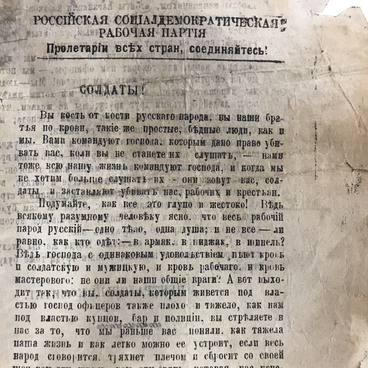The medal was minted from metal in the late 19th century. The head side of the medal (obverse) has an image of the Moscow coat-of-arms, with St. George the Victorious in front of a heraldic shield. Underneath it is an image of a cat and the inscription ‘10,000.’ The tail side of the medal features two inscriptions reading: ‘1897–1901’ and ‘Moscow Joint-Stock Association of the Railcar-Building Plant’.
The Mytishchi Railcar-Building Plant was established in 1897 in Mytishchi, near the railroad station. It was founded by Savva Mamontov, coming from a family of long-standing honorary citizens, the nobleman Konstantin Artsybushev and the temporary merchant of the Moscow 1st Guild, the engineer Alexander Bari. At the end of 1895, they presented their project titled ‘The Moscow Joint-Stock Association of the Railcar-Building Plant’ to the Russian Ministry of Finance.
In January 1896, the Ministerial Committee granted their permission, and, according to the tradition that existed back then, Emperor Nikolas the Second himself approved their Charter. The factory was equipped to manufacture railway rolling stock and spare parts. The first thing it made were cars for the Northern Railroad of Russia. Later, they started making tramway cars and snowplows for Moscow, and transportation platforms for military machinery when World War One broke out.
According to the ‘Brief Description’, in 1901 the factory was composed ‘of the following departments and workshops: an iron and copper foundry department, model workshop, mechanical forge, hydraulic forge and spring department, engineering department with a tool workshop, drilling, channel, and plate-flattening departments, a woodworking and carpentry department, assembly departments for freight cars and passenger cars, a paint shop for passenger cars, an engine room, an electric power station, a central group of boilers, a mechanical laboratory, a shop, and a timber warehouse’.
Years later, the factory now known as ‘Metrovagonmash’ is still manufacturing transportation vehicles. It specializes in the design and manufacturing of rolling stock for metro and railroads. In total, it has produced over 9,000 cars carrying more than 16 million passengers in 11 countries.
The Mytishchi Railcar-Building Plant was established in 1897 in Mytishchi, near the railroad station. It was founded by Savva Mamontov, coming from a family of long-standing honorary citizens, the nobleman Konstantin Artsybushev and the temporary merchant of the Moscow 1st Guild, the engineer Alexander Bari. At the end of 1895, they presented their project titled ‘The Moscow Joint-Stock Association of the Railcar-Building Plant’ to the Russian Ministry of Finance.
In January 1896, the Ministerial Committee granted their permission, and, according to the tradition that existed back then, Emperor Nikolas the Second himself approved their Charter. The factory was equipped to manufacture railway rolling stock and spare parts. The first thing it made were cars for the Northern Railroad of Russia. Later, they started making tramway cars and snowplows for Moscow, and transportation platforms for military machinery when World War One broke out.
According to the ‘Brief Description’, in 1901 the factory was composed ‘of the following departments and workshops: an iron and copper foundry department, model workshop, mechanical forge, hydraulic forge and spring department, engineering department with a tool workshop, drilling, channel, and plate-flattening departments, a woodworking and carpentry department, assembly departments for freight cars and passenger cars, a paint shop for passenger cars, an engine room, an electric power station, a central group of boilers, a mechanical laboratory, a shop, and a timber warehouse’.
Years later, the factory now known as ‘Metrovagonmash’ is still manufacturing transportation vehicles. It specializes in the design and manufacturing of rolling stock for metro and railroads. In total, it has produced over 9,000 cars carrying more than 16 million passengers in 11 countries.


